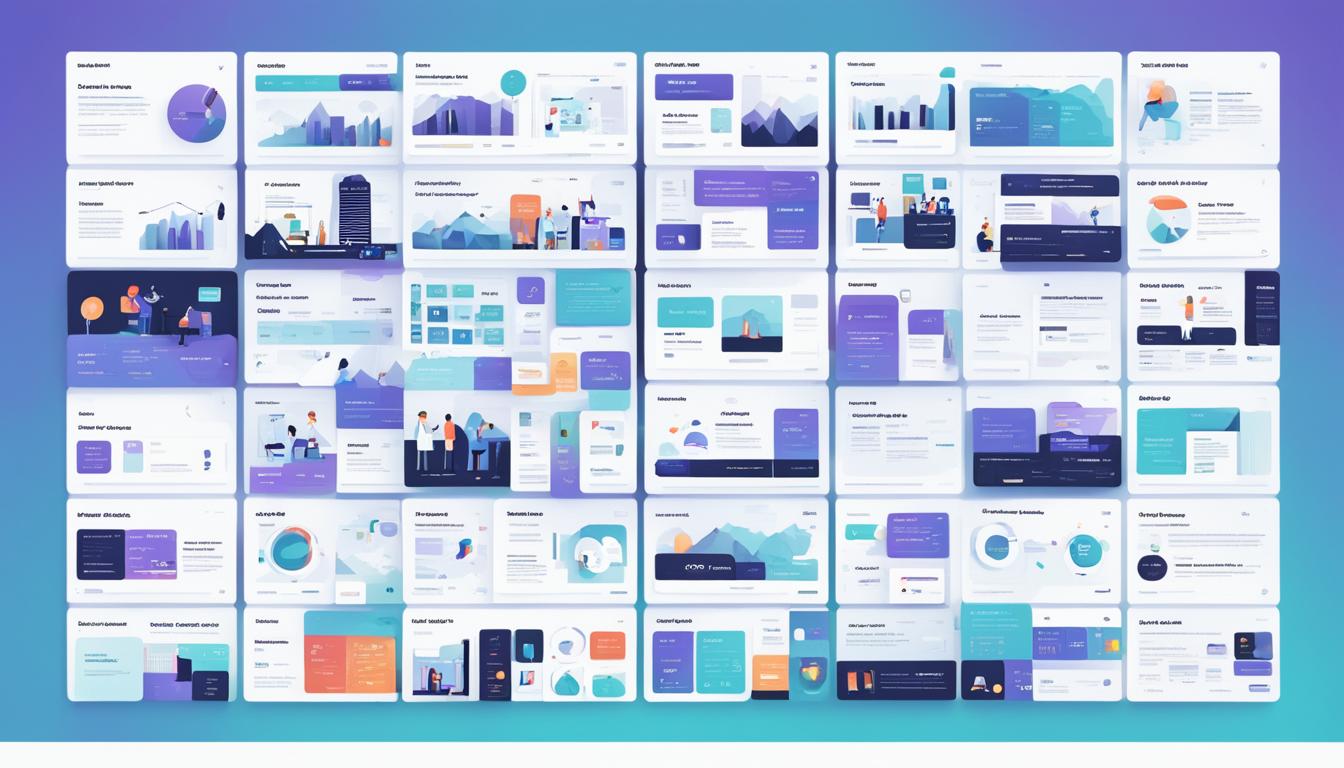Are you a blogger looking to boost your blog’s visibility and attract organic traffic? If so, incorporating SEO writing techniques into your blog posts is crucial. SEO, or search engine optimization, plays a vital role in improving your website’s search engine rankings and increasing your chances of reaching your target audience.
So, how can you write blog posts that are optimized for SEO? In this article, I will share valuable tips and strategies to help you optimize your blog content, improve your SEO performance, and drive more traffic to your website.
When it comes to writing for SEO, there are several key strategies to keep in mind. By implementing these tips, you can enhance the visibility of your blog posts and attract more readers.
Key Takeaways:
- Keyword optimization is crucial for improving your blog’s visibility in search engine results.
- Understanding user intent helps you create content that aligns with what people are actively searching for.
- Ensuring readability through clear and concise writing makes your blog posts enjoyable and valuable to readers.
- Historical optimization involves updating and improving older blog posts to maintain their relevance and freshness.
- Incorporating these SEO writing tips will help you optimize your blog content and improve your SEO performance.
What is SEO Writing?
SEO writing is a fundamental aspect of search engine optimization that focuses on creating content optimized to rank highly on search engines like Google. As a blogger, understanding SEO writing is crucial in order to increase your blog’s visibility, attract organic traffic, and improve your rankings on search engine results pages (SERPs).
So, what exactly does SEO writing entail? It involves various strategies and techniques, such as:
- Researching keywords: By identifying relevant keywords that align with your blog’s topic and target audience, you can optimize your content for search engines.
- Writing high-quality content: Producing valuable and engaging content is key to attracting both readers and search engine algorithms.
- Matching user intent: Understanding what users are searching for and creating content that fulfills their needs and intentions.
- Optimizing headers: Structuring your blog posts with clear and descriptive headers helps search engine crawlers comprehend your content.
The goal of SEO writing is to increase organic traffic to your blog and improve conversions. By incorporating relevant keywords and understanding user intent, you can create content that aligns with what people are searching for and improve your chances of ranking higher in search results.
Why is SEO Content Writing Important?

SEO content writing plays a critical role in improving the visibility and ranking of your website on search engine results pages. Without proper SEO optimization, your content is unlikely to rank highly and attract organic traffic. Numerous studies have shown that websites in higher positions on the SERP enjoy higher clickthrough rates, while those on later pages suffer from significantly lower clickthrough rates.
“Websites in higher positions on the SERP have higher clickthrough rates.”
This means that if your website does not appear on the first page of search results, the chances of attracting organic traffic are minimal. SEO content writing is a cost-effective strategy that can boost your website’s visibility, generate leads, and increase conversions without relying heavily on paid advertising.
By crafting content that is optimized for search engines, you can enhance your website’s visibility and improve its chances of reaching a wider audience. SEO content writing aims to increase your website’s organic traffic, ultimately leading to more clickthroughs, engagement, and conversions.
| Benefits of SEO Content Writing: |
|---|
| Improved website visibility |
| Higher clickthrough rates |
| Increased organic traffic |
| Generation of leads and conversions |
Investing time and effort in SEO content writing can yield long-term benefits, as your website is more likely to rank highly on search engines. This can result in a consistent flow of targeted organic traffic, making it easier to generate leads and achieve your business goals.
Additionally, SEO content writing ensures that your website remains competitive in the crowded digital landscape. By optimizing your content, you increase its relevance and align it with the expectations of search engine algorithms. This increases the likelihood of your website being ranked higher, improving its visibility to potential customers.
In the next section, we will explore the fundamentals of SEO content writing and provide you with essential tips to optimize your blog posts for search engines.
The Basics of SEO Content Writing

To master SEO content writing, it’s important to understand the basics. Let’s explore the fundamental principles that form the foundation of effective SEO content writing:
Keyword Optimization
Keyword optimization involves strategically using relevant keywords and phrases in your content to improve visibility and ranking. By researching and targeting the right keywords, you can increase your chances of appearing in search results when users are looking for information related to your content.
User Intent
Understanding user intent is crucial for creating content that aligns with what people are looking for when they search online. By identifying the needs and desires of your target audience, you can tailor your content to provide relevant and valuable information, increasing the likelihood of engagement and conversions.
Readability
Readability plays a significant role in making your content enjoyable and valuable to readers. By structuring your paragraphs, using headings, and incorporating lists and bullets, you can improve the flow and smoothness of your writing. Additionally, using clear and concise language makes your content easily understandable and accessible to a wider audience.
Historical Optimization
Historical optimization involves updating and improving older blog posts to ensure their relevance and freshness in search engine rankings. By identifying underperforming content and making necessary updates, such as refreshing statistics, adding relevant information, or enhancing the overall readability, you can boost the visibility and ranking of your existing content.
Incorporating these essential practices into your SEO content writing strategy will help you create high-quality, engaging, and optimized content that resonates with both search engines and readers.
Tips on How To Incorporate SEO in Your Writing
When it comes to incorporating SEO into your writing, there are several strategies and techniques you can use. These tips will help you optimize your blog posts for SEO and improve your chances of ranking higher in search engine results.
1. Conduct Keyword Research
Before you start writing, it’s important to conduct keyword research to identify the most relevant and high-performing keywords for your topic. Use keyword research tools to find keywords that have a high search volume and low competition. Incorporate these keywords naturally into your content to improve your chances of ranking higher in search engine results.
2. Use Headings to Organize Your Content
Headings not only help to break up your content and make it more scannable for readers, but they also play a role in SEO. Use headings (such as H2 and H3 tags) to structure your content and include your target keywords in them. This helps search engines understand the main topics of your blog post and improves your chances of ranking for those keywords.
3. Optimize for Featured Snippets
Featured snippets are the small snippets of information that appear at the top of search engine results pages. These snippets provide concise answers to users’ queries and can significantly boost your visibility. To optimize for featured snippets, provide clear and concise answers to frequently asked questions related to your topic. Use numbered lists, tables, or bullet points to present information in a way that is easy for search engines to understand and display as a featured snippet.
4. Write for Humans, Not Just Search Engines
While it’s important to optimize your content for search engines, don’t forget that you’re writing for humans. Focus on creating valuable and engaging content that meets the needs of your target audience. Write in a conversational tone, use storytelling techniques, and provide practical tips and advice. When readers find your content helpful and enjoyable to read, they are more likely to stay on your page, share your content, and increase your chances of earning backlinks and social shares.
5. Optimize Your Title, Meta Description, and Alt Text
Your title, meta description, and alt text are crucial elements for SEO. Your title tag should include your target keyword and provide a concise description of your content. Your meta description should provide a brief summary of your content and entice users to click on your link. Finally, optimize the alt text for your images by including relevant keywords that describe the image.
6. Avoid Keyword Stuffing
While it’s important to include your target keywords in your content, avoid keyword stuffing. Keyword stuffing refers to the excessive use of keywords in an unnatural or spammy way. Search engines can penalize websites that engage in this practice. Instead, focus on creating high-quality content that provides value to your readers and incorporates keywords naturally.
7. Build Links from High-Authority Websites
Link-building is an important aspect of SEO. Seek opportunities to build links from high-authority websites within your niche. Guest posting, collaborating with influencers, and participating in industry forums or communities are effective ways to earn backlinks. These backlinks not only improve your search engine rankings but also drive referral traffic to your blog.
8. Create Scannable Longer Posts
Longer blog posts tend to perform better in search engine rankings. However, it’s important to make your content scannable for readers. Use subheadings, bullet points, and numbered lists to break up your content and make it easier to read. Incorporate relevant images, infographics, and videos to enhance engagement and provide visual interest.
9. Implement Internal Linking
Internal linking refers to linking to other relevant pages within your own website. This helps search engines understand the structure and hierarchy of your website, improving the crawling and indexing process. Additionally, internal linking can help to distribute link equity, drive traffic to other pages on your website, and improve the user experience.
10. Optimize Your Images
Image optimization is often overlooked but plays a vital role in SEO. Optimize your images by compressing them to reduce file size and improve page loading speed. Use descriptive file names and include relevant keywords in your image alt text. This helps search engines understand what your images depict and improves your chances of appearing in image search results.
11. Develop a Link-Building Strategy
Link-building is an ongoing process that requires a well-defined strategy. Identify target websites and influencers in your niche and reach out to them for collaboration opportunities. Guest posting, creating valuable content, and fostering relationships in your industry are all effective link-building strategies. Remember, quality backlinks from reputable websites can significantly improve your search engine rankings and drive organic traffic to your blog.
By implementing these tips, you can effectively incorporate SEO into your writing and improve your blog’s visibility, traffic, and search engine rankings.
The Importance of Blog SEO

Blog SEO is crucial for attracting organic search results and reaching your target audience. By conducting keyword research and understanding what content your readers are looking for, you can create blog posts that rank higher in search engine results.
Adding visuals, such as images and videos, helps improve visibility and engagement. A visually appealing and relevant image can capture readers’ attention and enhance their overall experience. For example, a blog post about home decor ideas could include an image of a beautifully designed living room.
Writing a catchy title that piques the reader’s interest increases the chances of them clicking on your blog post. A title like “10 Easy Ways to Boost Your Productivity” is more enticing than a generic title like “Productivity Tips.”
The use of an enticing call to action (CTA) guides the reader to the next step and encourages further engagement. For example, a CTA like “Discover more productivity hacks in our free ebook” can entice readers to download the ebook and continue exploring your website.
Prioritizing the reader’s experience through readability, formatting, and page speed enhances the overall quality of your blog post and improves its SEO performance. Organize your content with headings (H3) to improve scannability and make it easier for readers to navigate through your post. Proper formatting, such as bullet points and numbered lists, helps break up text and makes it more visually appealing. Additionally, optimizing your website’s loading speed ensures a seamless reading experience for your audience.
By incorporating these blog SEO strategies, you can attract organic traffic, engage with your target audience, and improve the overall performance of your blog.
| Benefits of Blog SEO | Examples |
|---|---|
| Increase organic search results | Ranking higher on Google search results pages |
| Reach your target audience | Attracting readers interested in your niche |
| Improve visibility | More people discovering and visiting your blog |
| Enhance reader experience | Engaging content with easy navigation and fast loading times |
Blog SEO Strategy

Having a blog SEO strategy is crucial for improving organic search results and maximizing the effectiveness of your blog. By implementing a well-defined strategy, you can increase visibility, attract more organic traffic, and achieve your business goals. Key elements of a successful blog SEO strategy include:
- Competitive Research: Analyzing your competitors’ SEO tactics provides valuable insights into what works in your industry. Identify their keywords, content strategies, and backlink profiles to gain a competitive advantage.
- Keyword Lists: Creating comprehensive keyword lists allows you to target the most relevant and high-performing keywords in your blog posts. Conduct thorough keyword research to identify popular search terms and optimize your content accordingly.
- Optimization Proposal: Developing an optimization proposal outlines the steps and recommendations for enhancing your blog’s SEO performance. This proposal may include on-page optimization, technical SEO improvements, content updates, and link-building strategies.
Executing a blog SEO strategy enables you to focus your efforts, measure success, and optimize your blog for search engines. By combining competitive research, keyword optimization, and an optimization proposal, you can elevate your blog’s visibility, drive organic traffic, and achieve long-term success.
| Component | Description |
|---|---|
| Competitive Research | Analyze competitors’ SEO tactics to gain insights and identify opportunities for improvement. |
| Keyword Lists | Create comprehensive keyword lists to target relevant and high-performing keywords in your blog posts. |
| Optimization Proposal | Develop a plan with actionable steps to optimize your blog for SEO and improve performance. |
Conclusion
In conclusion, incorporating SEO into your blog writing is crucial for optimizing your website, attracting organic traffic, and improving search engine rankings. By implementing effective SEO writing techniques such as keyword optimization, understanding user intent, prioritizing readability, and utilizing historical optimization strategies, you can enhance the performance of your blog posts and improve your overall SEO outcomes.
Remember to conduct thorough keyword research, create a clear structure with headings, and optimize your content to be featured in snippets. Additionally, always prioritize writing for humans by delivering valuable and engaging content. Don’t forget to optimize your title, meta description, and alt text for search engines. By implementing these strategies, you can significantly improve your blog’s SEO performance and drive more organic traffic to your website.
Optimizing your blog posts for SEO is not only about increasing visibility and generating organic traffic, but also about providing valuable content that resonates with your target audience. By continuously refining your SEO writing skills and staying up-to-date with the latest industry trends, you can consistently improve your blog’s search engine rankings and overall visibility, ultimately leading to greater success for your website.










